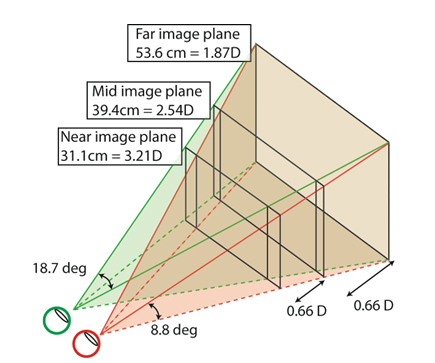
background
In stereo displays, binocular disparity creates a striking impression of depth. The added parallax information allows the visual system to infer a great deal of information about the 3D scene geometry. However, these displays present focus cues incorrectly. All depicted 3D objects have the focus signal of the flat screen. Presenting inconsistent disparity and focal signal causes the visual system to uncouple its neural mechanisms to properly focus and converge the eyes. This can result in problems including misperception of the 3D layout, difficulty fusing binocular images, and visual fatigue. To address these problems, we have developed two volumetric displays. These research tools provide us with an exciting workbench to study how the visual system combines various depth cues to form a unified percept. In addition, these displays allow us to test new software and optical techniques of simulating correct focus cues. We currently have two different volumetric displays that each rely on a different optical principle to control focal information. In the switchable lens display we utilize state of the art liquid crystal optics and birefringent transparent materials to create a lens system that can change focal power at up to 1000 Hz with no moving parts. In our other display, the three mirrors display, we utilize mirror beam splitters to create multiple different focal distances with a single display. We have shown that these displays can dramatically improve the ease, comfort and accuracy of perceiving stereoscopic stimuli.
One of the key principles underpinning our displays is that we used fixed viewpoint assumptions. This means that we will show images that are calculated specifically for each eyes’ viewing position. Knowing the head position allows us to show nearly all depth signals correctly. This is a large advantage over many other advertised volumetric displays that cannot handle occlusions, and reflections correctly.
Fixing the viewpoint also allows us to paramertize a scene as a 2D projection and the associated depth. It is important to have a very high spatial resolution as the visual system can resolve very fine angular displacements of objects. By comparison, its ability to resolve focal depth is coarse. We can use computer graphics techniques to present a broad range of focal distances with a limited number of discrete focal planes.

The tent filter (depth weighted blending) allows us to present intermediate focal distances using the discrete focal planes. The blue horizontal bars depict the way in which the light intensity for intermediate positions is distributed to the adjacent planes.

Illustration of 3 mirrors display. The display achieves the image-plane superposition with mirror-beam splitters (not shown), and achieves the binocular separation using a periscope assembly.

Switchable lens volumetric display. Lens state and pixel illumination over time. The red shading denotes the intensity of objects in that region of the frustum. The on screen image is updated so that it displays an appropriate part of the scene for each focal state of the lens.




